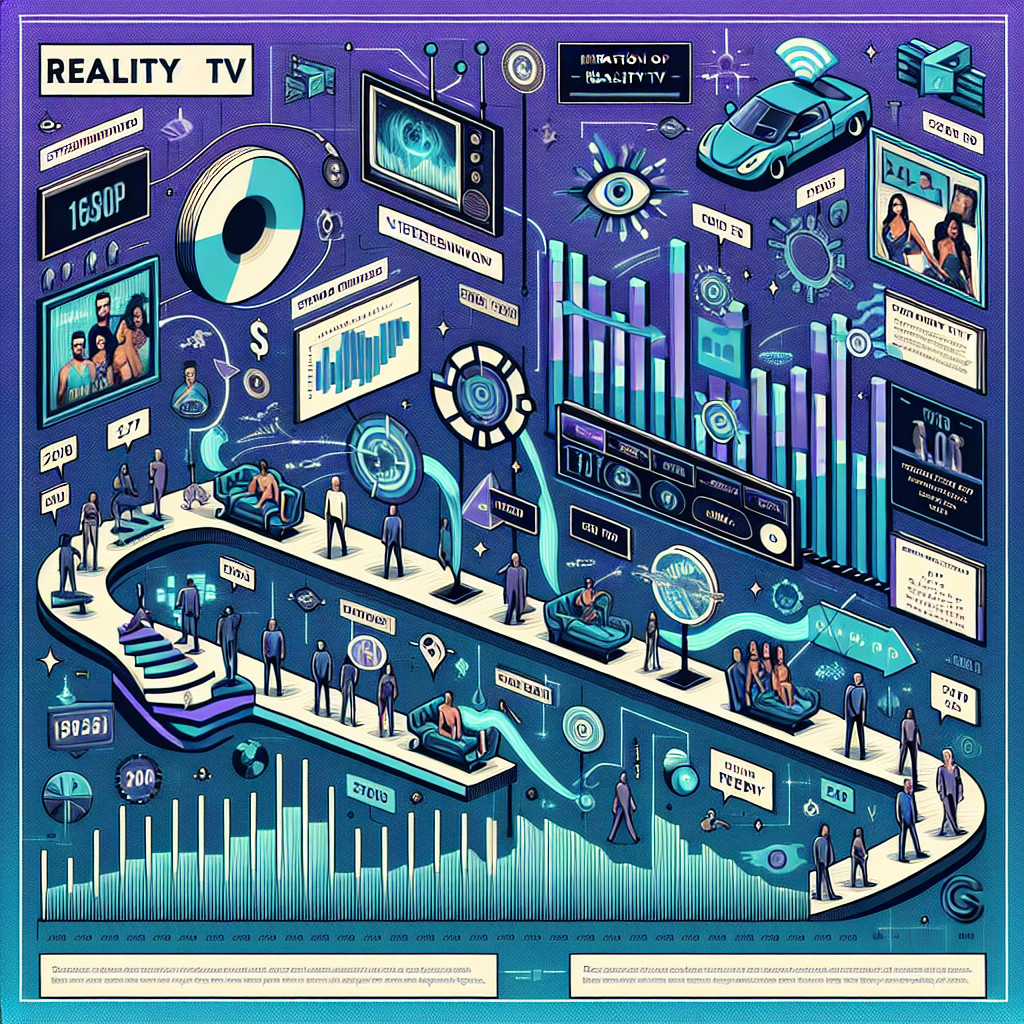Welcome to the captivating world of reality TV streaming services, where drama, excitement, and entertainment collide to create a truly immersive viewing experience. In recent years, the landscape of reality television has been forever transformed by the rise of streaming platforms. From heart-pounding competitions to jaw-dropping special moments, these services offer a vast array of reality TV shows that cater to every taste and preference. Join us as we dive into the evolution and impact of these streaming services, exploring how they have redefined the way we consume and interact with reality TV programming. Get ready to binge-watch your favorite shows like never before!
The Rise of Reality TV on Streaming Platforms
In recent years, the landscape of reality television has undergone a significant transformation with the rise of streaming platforms. Here are some key details outlining the evolution of reality TV on streaming services:
- Diverse Content Offerings: Streaming platforms have provided a breeding ground for a diverse range of reality TV shows, catering to various interests and demographics. From competitive cooking shows to dating experiments and home renovation challenges, streaming services have expanded the genre beyond traditional formats.
- Original Programming: Streaming platforms have invested heavily in producing original reality TV content, offering audiences fresh and innovative concepts that may not have thrived on traditional television. This shift has allowed for greater creative freedom and experimentation in the genre.
- On-Demand Viewing: One of the defining features of streaming services is the ability for viewers to access content on-demand. This has revolutionized the way audiences engage with reality TV, allowing them to binge-watch entire seasons at their convenience, leading to increased viewer engagement and loyalty.
- Global Reach: Streaming platforms have a global reach, enabling reality TV shows to attract a diverse international audience. This has facilitated cross-cultural exchanges and the adaptation of successful reality formats from one market to another, contributing to the globalization of reality TV.
- Interactive Features: Some streaming services have incorporated interactive features into reality TV shows, allowing viewers to participate in voting, decision-making, or influencing the outcome of the show. This level of interactivity enhances viewer immersion and creates a more dynamic viewing experience.
Popular Streaming Services for Reality TV

Mainstream Platforms
- Netflix
- Netflix has become a dominant player in the realm of reality TV streaming, offering a diverse range of original reality shows alongside licensed content.
- The platform’s subscription plans vary in price and features, with different tiers allowing for HD or Ultra HD streaming on multiple devices.
- Netflix’s reality TV library includes popular series like “Queer Eye,” “The Circle,” and “Too Hot to Handle,” catering to a wide audience demographic.
- The user experience on Netflix is characterized by intuitive navigation, personalized recommendations, and the ability to binge-watch entire seasons of reality shows.
- Hulu
- Known for its combination of live TV and on-demand streaming, Hulu has also made significant strides in the reality TV genre.
- Subscribers can access a mix of current reality TV episodes shortly after they air on traditional television, as well as an archive of past seasons for binge-watching.
- Hulu offers different subscription options, including a plan with limited commercials and an ad-free tier for uninterrupted viewing.
- Reality TV enthusiasts can enjoy shows like “The Bachelor,” “Keeping Up with the Kardashians,” and “90 Day Fiancé” on Hulu, enhancing the platform’s appeal to diverse reality TV fans.
- Amazon Prime Video
- Amazon Prime Video has emerged as a key player in the streaming landscape, offering a blend of original programming and licensed content, including reality TV series.
- Subscribers to Amazon Prime gain access to a growing library of reality shows, spanning genres like dating, competition, and lifestyle.
- The platform’s subscription model includes the option to purchase or rent individual episodes or seasons of reality TV shows not included in the Prime Video catalog.
- Amazon Prime Video’s interface is user-friendly, with features like X-Ray providing additional information about the cast and crew while watching reality TV content.
Niche Platforms
- Specialized Platforms: Niche streaming services have emerged catering specifically to fans of particular reality TV genres, offering a curated selection of shows that may not be readily available on mainstream platforms.
- Diverse Genres: These platforms delve into a wide range of reality TV sub-genres, from culinary competitions to home renovation shows, attracting audiences with specific interests and preferences.
- Exclusive Content: Niche platforms often feature exclusive content that caters to the devoted fan base of certain reality TV niches, providing access to shows that may not have gained widespread popularity but hold significant appeal to a targeted audience.
- Interactive Experiences: Some niche platforms offer interactive experiences for viewers, allowing them to engage with the content in unique ways such as voting for outcomes or participating in challenges related to the shows they are watching.
The Influence of Streaming on Reality TV Trends
- Impact of streaming on the production and distribution of reality TV shows:
- Streaming services have revolutionized the production and distribution of reality TV shows by offering a platform for a diverse range of content that traditional television networks may not have supported. This has led to an increase in the variety and quality of reality programming available to viewers.
- Streaming platforms often provide opportunities for niche reality shows to thrive, as they are not constrained by the same commercial pressures as traditional networks. This has allowed for the creation of unconventional and boundary-pushing reality content that appeals to specific audiences.
- The direct-to-consumer model of streaming services has also enabled reality TV producers to experiment with different formats, episode lengths, and release schedules, leading to a more dynamic and innovative landscape for the genre.
- Discussion on how streaming platforms have shaped viewer preferences and trends:
- Streaming platforms have introduced a binge-watching culture that has influenced how viewers consume reality TV. Audiences now have the freedom to watch entire seasons of reality shows in one sitting, leading to increased engagement and immersion in the content.
- The personalized recommendation algorithms used by streaming services have also played a significant role in shaping viewer preferences for reality TV. By analyzing viewing habits and preferences, these platforms can suggest tailored reality content to viewers, leading to increased viewership and retention.
- Furthermore, the global reach of streaming services has exposed viewers to reality TV shows from different cultures and regions, contributing to the diversification of viewer preferences and the globalization of the genre.

The Evolution of Reality TV Content on Streaming Services
Diversification of Genres
- Inception of Niche Reality Subgenres: Streaming services have fostered an environment where niche reality subgenres thrive, catering to specific interests and demographics. From culinary competitions to home renovation shows, viewers can delve into a myriad of specialized content that may not have been as prevalent on traditional television platforms.
- Global Influence on Genre Diversity: The global reach of streaming services has significantly impacted the diversification of reality TV genres. International reality formats are now easily accessible to a broader audience, leading to a cross-pollination of ideas and the adaptation of successful formats from different regions. This globalization of content has enriched the genre landscape, offering viewers a more eclectic selection to choose from.
- Emphasis on Authentic Representation: With the rise of streaming services, there has been a shift towards showcasing authentic and diverse representations of individuals and communities in reality TV. This emphasis on authenticity has led to the proliferation of documentaries and docuseries that explore real-life experiences and social issues, adding depth and substance to the genre beyond traditional reality show formats.
Interactive and Immersive Experiences
- Analysis of interactive reality TV shows on streaming platforms: Streaming services have revolutionized the way viewers engage with reality TV content through interactive experiences. Platforms like Netflix and Hulu have introduced interactive shows where viewers can make choices that directly impact the storyline. For example, in shows like “Bandersnatch” on Netflix, viewers can choose different paths, leading to multiple endings, creating a personalized viewing experience.

– Enhanced viewer engagement and participation: The integration of technology in streaming services has elevated viewer engagement to new heights. By allowing viewers to interact with the content, streaming platforms have transformed passive watching into an immersive experience. Viewers are not just spectators but active participants in shaping the narrative, creating a sense of agency and investment in the content. This level of interactivity has blurred the lines between reality and fiction, making reality TV more captivating and dynamic for audiences.
Challenges and Opportunities in the Streaming Reality TV Landscape
Content Discovery and Recommendation Algorithms
In the realm of streaming reality TV, the landscape is heavily influenced by the mechanisms of content discovery and recommendation algorithms. These algorithms play a pivotal role in suggesting reality TV content to viewers, shaping their viewing experiences and preferences.
Discussion on the role of recommendation algorithms in suggesting reality TV content
Recommendation algorithms analyze user data, viewing history, and preferences to predict what content a viewer may enjoy watching. In the context of reality TV, these algorithms scrutinize a wide array of factors, including past viewing habits, genre preferences, and even viewing times to suggest relevant reality TV shows or episodes. By leveraging machine learning and artificial intelligence, streaming services can tailor their recommendations to cater to the unique tastes and interests of individual viewers.
Challenges faced by streaming services in curating personalized recommendations for viewers
Despite the advancements in recommendation algorithms, streaming services encounter several challenges in curating personalized recommendations for viewers in the reality TV genre. One major hurdle is the diversity within reality TV content itself, spanning from competition-based shows to docuseries and lifestyle programs. This variety poses a challenge for algorithms to accurately predict viewer preferences, as individual tastes within the reality TV genre can vary significantly.
Moreover, the issue of oversaturation of reality TV content on streaming platforms adds another layer of complexity. With an abundance of reality TV shows available for viewers to choose from, recommendation algorithms must navigate through a vast pool of content to offer relevant suggestions. Balancing between popular mainstream reality shows and niche, lesser-known programs further complicates the task of curating recommendations that resonate with viewers.
In essence, while recommendation algorithms have revolutionized the way viewers discover and engage with reality TV content on streaming services, the challenges of catering to diverse preferences and navigating through a vast content library continue to shape the evolution and impact of streaming services in the realm of reality TV.
Monetization Strategies
- Exploration of monetization models for reality TV content on streaming platforms
In the evolving landscape of streaming services for reality TV, various monetization strategies have emerged to capitalize on the popularity of this genre. One prevalent model is the subscription-based approach, where viewers pay a recurring fee to access a library of reality TV shows. This model offers a steady revenue stream for streaming platforms while providing viewers with unlimited content consumption. Additionally, ad-supported monetization has gained traction, allowing platforms to offer free access to reality TV shows in exchange for viewing advertisements. This strategy not only generates revenue through ad placements but also expands the audience reach by lowering the barrier to entry for viewers.
- Impact of subscription-based, ad-supported, and premium content offerings on revenue generation
Subscription-based models have proven to be a lucrative avenue for revenue generation in the streaming reality TV landscape. By enticing viewers with exclusive content and ad-free viewing experiences, platforms can attract a dedicated subscriber base willing to pay for premium access. On the other hand, ad-supported models provide an alternative revenue stream by leveraging advertisers’ interest in reaching a captive audience through targeted commercials. Moreover, premium content offerings, such as early access to episodes or behind-the-scenes footage, can further monetize reality TV content and enhance the overall viewer experience. The combination of these monetization strategies has reshaped the traditional TV industry, driving the growth of streaming services and transforming the way reality TV is consumed and monetized.
Future Trends and Innovations in Reality TV Streaming
Future Trends and Innovations in Reality TV Streaming
The future of reality TV content delivery via streaming services is poised for significant evolution and transformation. As the landscape continues to shift towards digital platforms, several key trends and innovations are shaping the future of reality TV streaming:
- Personalized Viewing Experiences: Streaming services are increasingly leveraging data analytics and AI algorithms to offer personalized recommendations to viewers, enhancing engagement and retention. Future trends suggest a more tailored approach to reality TV content delivery based on individual preferences and viewing habits.
- Interactive Viewing Experiences: The integration of interactive elements such as live polling, viewer voting, and real-time social media interactions is becoming more prevalent in reality TV streaming. This trend is expected to grow, allowing audiences to actively participate in shaping the outcomes of their favorite reality shows.
- Immersive Technologies: Virtual reality (VR) and augmented reality (AR) are poised to revolutionize reality TV streaming by offering immersive, 360-degree experiences to viewers. The adoption of these technologies will transport audiences directly into the heart of the action, providing a more engaging and interactive viewing experience.
- Multi-platform Integration: The future of reality TV streaming will likely see increased integration across multiple platforms, allowing viewers to seamlessly transition between devices without any interruption in their viewing experience. This trend aims to enhance accessibility and convenience for audiences, catering to their diverse viewing preferences.
- Emerging Content Formats: With the rise of short-form content and serialized storytelling, reality TV streaming services are exploring new formats to captivate audiences. From docuseries to interactive documentaries, the future of reality TV content delivery will offer a diverse range of formats to cater to varying viewer interests.
- Global Expansion: As streaming services continue to expand their reach globally, the future of reality TV streaming will witness a more diverse range of content from different regions and cultures. This trend is expected to foster cross-cultural exchanges and collaborations, enriching the overall viewing experience for audiences worldwide.
In conclusion, the future of reality TV streaming is poised for innovation and transformation, driven by advancements in technology, changing viewer preferences, and the increasing globalization of content delivery platforms. As streaming services continue to evolve, the boundaries between traditional and digital media will blur, offering audiences a more personalized, interactive, and immersive viewing experience.
FAQs: Exploring the Evolution and Impact of Streaming Services for Reality TV
What are some popular streaming services for reality TV shows?
Some popular streaming services for reality TV shows include Netflix, Hulu, Amazon Prime Video, and HBO Max. These platforms offer a wide selection of reality TV content ranging from competition shows to documentaries, catering to various interests and preferences of viewers.
How has the evolution of streaming services impacted the way reality TV shows are produced and consumed?
The evolution of streaming services has provided an alternative distribution platform for reality TV shows, allowing for greater creativity and diversity in content. Producers are able to experiment with different formats and storytelling techniques, while viewers have the flexibility to binge-watch entire seasons at their convenience. Additionally, streaming services have enabled global audiences to access reality TV content from different parts of the world, contributing to the international popularity of the genre.
Can viewers expect new original reality TV content on streaming services?
Yes, streaming services are increasingly investing in original reality TV content to attract and retain subscribers. These platforms are commissioning new shows and working with established producers and talent to create fresh and engaging content that appeals to a broad audience. Original reality TV series on streaming services often have higher production values and creative liberties compared to traditional broadcast television.
Are there any advantages to watching reality TV shows on streaming services compared to traditional television?
One advantage of watching reality TV shows on streaming services is the lack of commercial interruptions, allowing for a more immersive viewing experience. Viewers also have the flexibility to watch episodes at their own pace, without being tied to a specific airing schedule. Additionally, streaming services often offer a wider selection of reality TV shows, including older seasons and exclusive content that may not be available on traditional television channels.